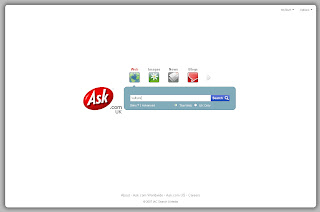By now you probably have a fuzzy idea of how a search engine works, but there’s much more to it than just the basic overview you’ve seen so far. In fact, search engines have several parts. Unfortunately, it’s rare that you find an explanation describing just how a search engine is made — that’s proprietary information that search companies hold very close to their vests — and that information is vitally important to succeeding with search engine optimization (SEO).
Query interface
The query interface is what most people are familiar with, and it’s probably what comes to mind when you hear the term ‘‘search engine.’’ The query interface is the page, or user interface, that users see when they navigate to a search engine to enter a search term. There was a time when the search engine interface looked very much like the Ask.com page shown in figure. This interface was a simple page with a search box and a button to activate the search, and not much more.

Today, many search engines on the Web have added much more personalized content in an attempt to capitalize on the real estate available to them. For example, Yahoo! Search, shown in Figure, is just one of the search services that now enable users to personalize their pages with a free e-mail account, weather information, news, sports, and many other elements designed to make users want to return to that site to conduct their web searches. One other option users have for customizing the interfaces of their search engines is a capability like the one Google offers. The Google search engine has a customizable interface to which users can add different gadgets. These gadgets enable users to add features to their customized Google search home page that meet their own personal needs or tastes.

Search has even extended onto the desktop. Google and Microsoft both have search capabilities that, when installed on your computer, enable you to search your hard drive for documents and information in the same way you would search the Web. These capabilities aren’t of any particular use to you where SEO is concerned, but they do illustrate the prevalence of search and the value that users place on being able to quickly find information using searching capabilities.
When it comes to search engine optimization, Google’s user interface offers the most potential for you to reach your target audience, because it does more than just optimize your site for search: If a useful tool or feature is available on your site, you can enable users to have access to this tool or feature through the Application Programming Interface (API) made available by Google. Using the Google API, you can create a gadget that users can install on their Google Desktop, iGoogle page, or Firefox or Chrome browser. This enables you to have your name in front of users on a daily basis.
For example, a company called PDF24.org offers a Google gadget that enables users to turn their documents into PDF files right from their Google home page once the gadget has been added. If the point of search engine optimization is ultimately to get your name in front of as many people as possible, as often as possible, then making a gadget available for addition to Google’s personalized home page can only further that goal.
-seo consultancy services-
No comments:
Post a Comment